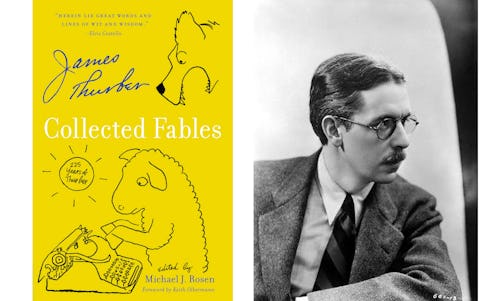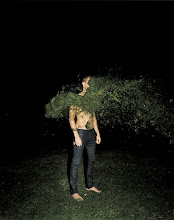Painting a Pinup
Caroline Porter wants to know what you think
Imagine a painting of a woman. OK, you're thinking, "I've seen about a million paintings of women." That's the problem, isn't it? A brief glance at femininity in the annals of art history and you might think you were looking at a classy Playboy. The female form has been a favorite subject of painters for generations, from Manet's "Olympia" to Da Vinci's "Madonna on the Rocks" to De Kooning's "Woman I-V," the permutations are limitless. The female abstracted, the female cubed, the female portrait, and the female photographed have all populated museum and exhibit walls for years. The University of Oregon's Bachelor of Fine Arts (BFA) show for fifth-year student painters was no different.
Caroline Porter's paintings are striking primarily because of the women in them. She uses pinup imagery as inspiration, not necessarily imagery that she directly appropriates. She takes liberties with certain dimensions of these 1940s and 50s-style underwear and swimwear models and the effect is striking - these ladies have big thighs, tiny waists and generous bosoms. The women Porter has painted for her BFA exhibit sit against simple, mostly monochromatic backgrounds of color (three have an all-black background and one is a dark yellow). So the question is, does she use pinups to appeal to men or to a sense of nostalgia that is inherently intriguing? Or is she using pinups to spoof an unfair standard of beauty that women are held up to? The great thing about Porter is, while she may have some ideas about the answer to these questions, she's really more interested in what you have to say about it.
Her paintings are all untitled with descriptors: "Untitled (yellow lady)," "Untitled (lady with dollhouse)," "Untitled (lady with pony)," "Untitled (lady with pop-up book)," and "Untitled (stuffed pasture)." Part of her collection is a 27-count hand-made group of stuffed sheep that all look the same but there is something unique about each of them. "For the longest time I wasn't sure what they meant and why I was doing it," she said. "I started putting something inside of them like a chestnut or a piece of paper." There is a certain pressure as a painter to be able to articulate some kind of idea or message that your art is communicating to an audience. "My professor is pressuring me about what they're about," Porter said.
"Untitled (lady with dollhouse)" is a good place to start. A smiling white woman is lying down on her stomach in a pink, old-fashioned, one-piece bathing suit against an even black background. Her wavy auburn hair falls behind her back and frames a huge grin on her face. Her bright red lips look as though she's wearing glittery lipstick and she's flashing an oversized bright white set of teeth. An inhumanly tiny waste leads your eyes to a plump rear and thighs, then to the probably four-inch heels that are pointed toward the sky. A pop-up book sits in front of her folded arms, but her hand on her face holds her gaze toward the viewer. A huge castle modeled from Disney's Magic Kingdom towers in front of her, rising from the book. All four of the women in her untitled paintings are holding - presenting, even - a childlike toy. The toys are another way of understanding what messages Porter is communicating with these paintings. "The toys are an opening for meaning. Thinking about the relationship between the toy and the woman is more interesting than just looking at the woman," she said. Porter suggested that the toys you play with as a child may shape the kind of adult you become. A girl who grows up reading fairytales and watching Disney movies, for instance, might develop aspirations of finding the man of her dreams, a Prince Charming. When you look at her paintings, if the gender roles were switched, you can imagine big burly men holding toy footballs or trucks. "She wants to show how meanings are not fixed," art history professor Kate Mondloch said of Porter's work. "She wants to open up meanings, for there not to be one fixed meaning. She's not forcing people to interpret them in any one way."
--------------------------------------------------------------------------------------
Porter is a fifth-year student in the University's BFA painting program; she's one of seven students receiving a more specialized degree than the BA in art. The BFA requires a BA or BS in art, an academic year (3 courses) and a 6-credit terminal project. The BFA students share two studios in the Millrace buildings on the edge of campus near the Willamette foot bridge. She shares a spacious white room with angled ceilings, split into two sets of two-person spaces by a temporary wall. Her fellow BFA students become an important part of the process. They share ideas, feedback and questions about each other's work. From the look of their collective space, they share a lot of music and energy as well.
"Your peers tend to be as big as the faculty in this [critique] process," said MFA painting student Grant Hottle. The MFA students sit in on the critiques of the BFA painters' work. It's a multi-faceted process where the painter's faculty advisors and peers ask questions of the artist. "The teacher usually starts the conversation with some questions about first impressions, then technique and process, and then to things like how the paint looks," Hottle said. How well a painter handles the subject matter he or she is painting about is definitely a concern in the critical process - true, too, of any discerning artistic eye.
The reactions to her terminal project opening in the Laverne Krause Gallery in Lawrence Hall (May 22nd-26th) were mixed. She reported a variety of responses: "Some people would say 'Man! She's hot!' and others would say 'Oh you're supporting the male-domination of men looking at women.'" So it seems yourre damned if you do and yourre damned if you donrt when you make paintings portraying women. "It's interesting when women are painted," Porter said, "Is it for women? Is it for men?" She also said that people were asking her what her paintings mean and using that classic phrase, "I don't get it."
"It doesn't matter what I think! Tell me what you think!" she said. She didn't have a statement prepared for her terminal project opening reception. Probably because she says, "Personally, I prefer subtle - not too obvious. For me, this work is a little more obvious. Do I want to explain it to people? Do I want people to explain it to me?" she asked. Clearly she's interested in engaging her audience, but she is not interested in distinct answers or a right way of looking at her work.
Porter said her ideas about a substantial message versus pure aesthetic appeal have evolved over the years. "My ideas have changed about this lately. It has to look good, they have to be aesthetically pleasing," she explained. "I definitely think there needs to be something there. If you're painting flowers but you're doing it because nobody does it anymore or you can't succeed doing it anymore, then that's different from just painting flowers." Her half of the studio is shared with Jeremy Munro, another BFA painter who painted huge portraits of laughing faces. Their faces are more than laughing; some of them look almost mad or appear to be laughing at the viewer. Munro's paintings are painted in a different style from Porter's; he uses thick layers of paint and Porter admires that about his portraits. But in terms of substance, some people will wonder if the painter intends for his audience to be laughed at or for them to laugh with each other at the well-painted and amusing facial expressions. "As a woman, does it feel like five huge white male faces laughing at me?" she asked.
----------------------------------------------------------------------------------------
Porter was born in Saudi Arabia and grew up in Singapore and Britain. She'll head back to England after this year to keep working on her painting and apply to graduate programs. She's shown her work at the Laverne Krause Gallery in Lawrence Hall (October 2005, April 2006, May 2006) and at Eugene's Shady Pines Last Friday Exhibit (February 2006, April 2006). The Shady Pines art walk is described in the Eugene Weekly as a "monthly self-guided tour of galleries, studios and sometimes living rooms around Eugene." Porter also claimed the first prize award at Max's Tavern's First Annual Art On!, a drawing competition put together by Adriane Brown. Each artist was selected to enter the competition mostly by invitation from Brown herself, a fellow BFA painter colleague of Porter's.
"Every time you bought a beer you got a vote," Brown explained. Between 75 and 100 votes were collected for the six artists' drawings that all contained three elements: travel, your favorite plant, and piercings. "It was a drawing of a woman sitting on a suitcase holding a plant," Brown described Porter's winning entry. Porter said her Art On! victory is "The highlight of my career!"
Porter explained that she's actually more into drawing than painting. She loves to draw and doodle, as evidenced by the kaleidoscope of work pinned above her studio desk. It's filled with drawings on index cards and other collectibles, like a My Little Pony box or a box of animal cookies. There's one drawing in particular that was a big inspiration for pursuing her work with pinups and the doll-like treatment of women. She was inspired while looking through a paper doll dress book. It's a graphite pencil drawing of two ladies, a brunette and a blond, in those old bathing suits again, standing in high heels with their hands lightly resting on their hips. The drawing is very realistic until you reach their heads - their mouths are almost unhinged and open to a nearly 180 degree angle. "Pencil's much more fun, subtler too and less of a mess," she said. "I was looking at paper doll drawings. That's where I found the bathing suits, then I drew their heads and legs."
The untitled paintings came about in a similar way. "I checked out a book on pinups and I liked George Petty's ads for underwear and girdles. They're airbrushed paintings or drawings he did for Esquire in the 40s and 50s," she said. Why pinups though? "I don't know, I was drawn to the women. They're loaded with imagery these days and you can mess with them a lot making their waists thinner or their asses huge. You can definitely take the feminist viewpoint if you want," she said. It definitely seems as though Porter is playing with the idea of a standard of beauty, how it's changed and how it hasn't changed over time.
"It was more like making fun of [the beauty standard]," she said. "It's obvious that it's bullshit but it's easier to make a point this way," Porter said. A big smiling blond with exaggerated curves playing with a dollhouse does seem to hint at a striking dichotomy between youth and adulthood. But what it is exactly that we are supposed to take from her paintings isn't as significant as the fact that her paintings make the viewer want to understand a message at all. Like most artists bold enough to challenge their audience, Porter seems to be pleased that her art puzzles some people. It wouldn't be fun any other way.





No comments:
Post a Comment